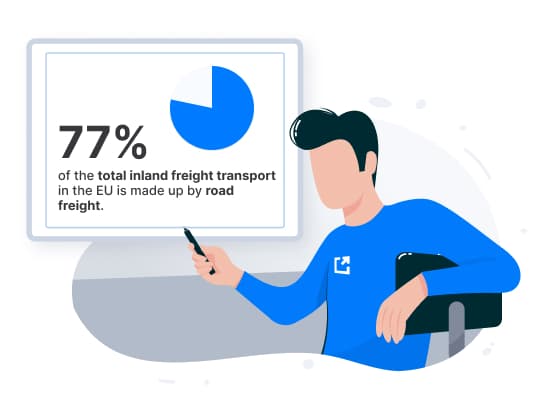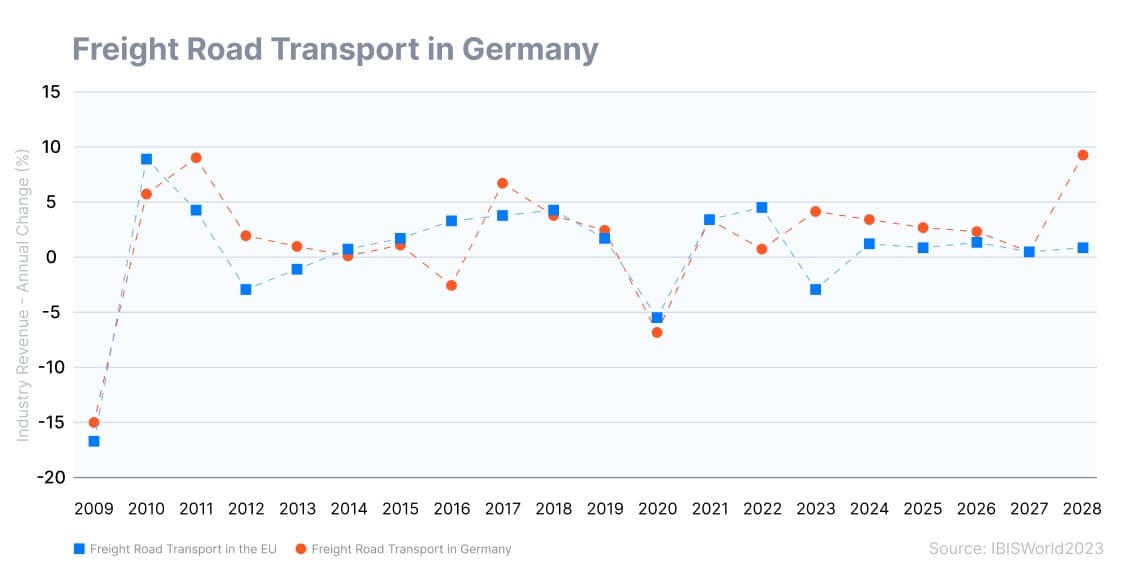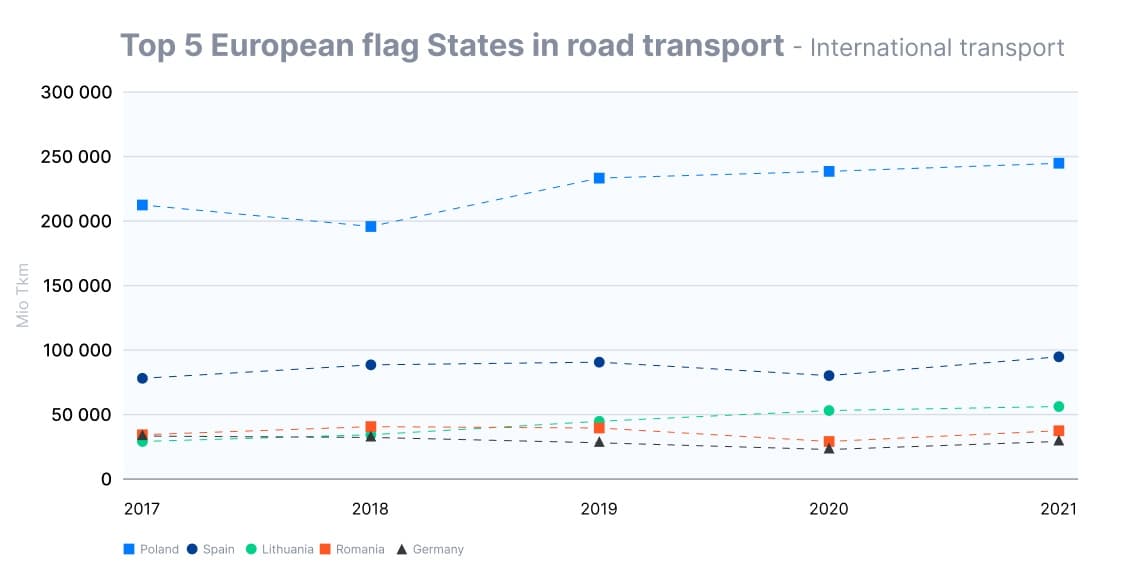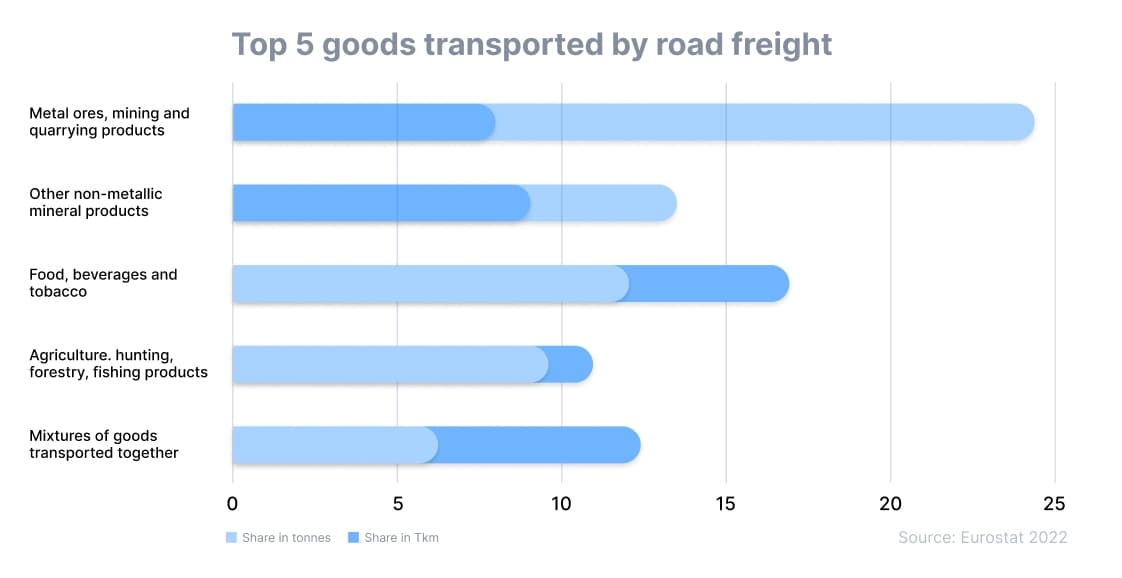Road freight forwarding statistics in Europe
Road freight transport plays a crucial role in Europe’s economy, facilitating the movement of goods across countries and connecting businesses with customers. The following statistics on road freight transport in Europe offer valuable insights into the industry’s size, trends, and its impact on various sectors.

General road freight transport statistics in Europe
While other modes of freight transport (air, sea, rail) are also necessary for today’s economy, road transport is the only mode that can offer the convenience of door-to-door delivery.
- Road transport makes up 77% of the total inland freight transport in the EU.
- In 2022, more than 13.6 billion tonnes of goods were transported by road in the EU.
- Almost 60% of the total tonnage transported in the EU in the year 2022 was attributed to Germany, Poland, France, Spain, and Italy.
- The total distance travelled by freight on European roads exceeds 1.7 trillion km.
- Heavy goods vehicles account for about 25% of CO² emissions in the transport sector.
Freight forwarding statistics: growth and decline trends
Following significant growth in previous years, the international road transport volumes within the EU are projected to decrease to 1.1% in 2023.
- Due to the impact of the Covid-19 pandemic, road freight transport in the EU witnessed a decline of 1% in 2020, which was then followed by a significant recovery in 2021, showing a growth rate of 6.5%.
- In 2022, the European road freight market saw a 3.5% growth, owing largely to post-pandemic recovery, but this progress was impeded by the war in Ukraine.
- SMEs make up 85% of the companies in the road transport sector, demonstrating flexibility to meet customer demands.
- Trucks carry 100 kg of goods for every EU citizen on a daily basis.
- The average age of trucks used for freight transport is 13.9 years.
Road freight transport statistics in Germany
Since 1980, Germany has maintained its position as the largest economy in Europe, even prior to the reunification of West and East Germany. Within the logistics world, Germany continues to hold the position of the largest logistics market in Europe. The industry numbers we see below serve as proof of their consolidation in the highest position on the market:
- In 2021, road freight transport in Germany increased by 2.6 billion tonne-kilometres compared to 2020.
- Germany had the highest amount of freight transported by road (in tonnes) within a national European territory in 2022.
- The transport of goods between Switzerland and Germany represented 17.6% of the total tonnage transported between the EU and non-EU countries.
- As of 2023, there are 35,587 freight transport businesses in Germany, an increase of 0.1% from 2022.
The graph below demonstrates the growth of the road freight transport industry in Germany in comparison to the overall growth across the EU, including predictions until the year 2028.

Freight transport statistics in Poland: a key player in the haulage industry
Accounting for 7% of Poland’s GDP, the road transport, forwarding, and logistics industry stands out a rapidly growing sector in the Polish economy. Below, you will see the numbers that have been leading to this market growth.
- The road freight transport sector in Poland experienced an average annual growth of 4.9% between 2010 and 2022.
- In 2021, Polish trucks accounted for 20% of the EU market.
- Over 80% of goods in Poland are transported by road freight.
- 15% of the transport on the key routes in Western Europe is handled by Polish companies.
Among the top EU markets, Poland stands out as the frontrunner in terms of tonne-kilometres (Tkm) transported by road freight, as depicted in the graph below.

Road freight cabotage transport in Europe
Cabotage refers to the transport of goods within a country by transport companies registered in another country. For instance, it can refer to the scenario of a Polish haulier providing transport services within Germany. Cabotage transport is heavily regulated by European laws.
Cabotage transport services take a small percentage of the overall national road freight transport, which can vary greatly from country to country. On average, cabotage transport took up 4.9% of national road freight transport in the EU in 2020. Below is the breakdown and trends of what has been happening in this industry sector:
- Over 50% of cabotage transport in the EU during 2020 was carried out in Germany.
- In 2020, Polish hauliers performed 45% of all cabotage transport in the EU.
- Cabotage transport was less impacted by the Covid-19 pandemic compared to national and international transport.
- There has been strong growth in cabotage by Croatian and Lithuanian hauliers since 2015.
- Interestingly, cabotage transport is not always executed by hauliers from neighbouring countries.
Road freight forwarding statistics by type of goods
Road transport plays a significant role in international trade. It allows easy transport of various types of goods across Europe.
- In 2022, road freight transport was predominantly dominated by the transport of food products, beverages, and tobacco, amounting to 317 billion tonne-kilometres.
- Metal ores, mining products, quarrying products, peat, uranium, and thorium were the product group with the highest percentage in terms of weight transported by road in the EU in 2021 (24.8%).
- With a share of 51.1%, flammable liquids stood out as the most prevalent type of dangerous goods transported in the EU in 2021.

Freight forwarding statistics: thoughts and conclusions
The freight forwarding industry operates in a highly competitive environment where market conditions and customer preferences can shift rapidly. As a result, it becomes crucial for stakeholders to stay on top of current freight forwarding and road transport statistics to make informed decisions and adapt their strategies accordingly.
As a leading freight forwarder operating in Europe and internationally, Eurosender aims to stay on top of current trends by continuously monitoring road freight transport statistics in Europe and providing efficient logistics solutions that meet the evolving needs of our customers.
We leverage advanced technologies and collaborate with our extensive network of partners to ensure seamless and reliable delivery of goods across borders.